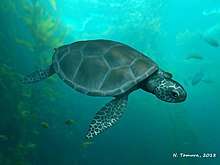Puppigerus
Puppigerus is an extinct genus of sea turtle from the Eocene. It is known from finds in the United States, the United Kingdom, Belgium, Denmark, and Uzbekistan.[2]
| Puppigerus | |
|---|---|
 | |
| P. camperi fossil on display at the Teylers Museum | |
| Scientific classification | |
| Kingdom: | Animalia |
| Phylum: | Chordata |
| Class: | Reptilia |
| Order: | Testudines |
| Suborder: | Cryptodira |
| Clade: | Pancheloniidae |
| Genus: | †Puppigerus Cope 1870 |
| Species | |
| |
Taxonomy
Puppigerus was described by Edward Drinker Cope in 1870.[3][4] As of 1997, P. camperi and P. crassicostata were considered the two valid species.[5] P. camperi was later thought to be the sole species of the genus until the 2005 discovery of P. nessovi from Uzbekistan.[2][6]
Description

Fossils show that Puppigerus was around 90 cm (35 in) long,[2] and its weight has been estimated as being somewhere around 9–14 kg (20–31 lb).[1] Although cheloniids such as Puppigerus first appeared during the Cretaceous, several traits of this genus give it more of a resemblance to modern cheloniids: its "huge" eyes pointed sideways rather than upward, unlike more primitive cheloniids, and its shell was completely ossified. The pygal (rearmost plate of the upper shell) also lacked the notch seen in earlier cheloniids.[2] It was a herbivore, living on marine vegetation, and one of the "best-adapted" prehistoric turtles; its "unusually large" eyes helped it gather as much light as possible, and its specialized jaw structure kept it from accidentally breathing in water. Its front legs were flipper-like, but its hind legs were not developed in this manner, suggesting it would have spent considerable time on dry land, where females would have laid their eggs.[1]
Palaeoecology
Puppigerus camperi is known from the London Clay and Bracklesham Beds of England, as well as the Sables de Bruxelles and the Sables de Wemmel of Belgium.[5] P. nessovi is known from the Dzheroi 2 locality of Uzbekistan.[6] A Puppigerus species is also known from the Fur Formation of Denmark.[7]
References
- Strauss, Bob. "Puppigerus". About.com. The New York Times Company. Retrieved April 16, 2012.
- Palmer, Douglas; et al. (2009). "Paleogene". Prehistoric Life: the Definitive Visual History of Life on Earth (first American ed.). New York City: DK Publishing. p. 377. ISBN 978-0-7566-5573-0.
- Scudder, Samuel Hubbard (1882–1884). Nomenclator Zoologicus: an Alphabetical List of All Generic Names That Have Been Employed by Naturalists for Recent and Fossil Animals from the Earliest Times to the Close of the Year 1879 (Google Books preview). Bulletin of the United States National Museum 19. Washington: Government Printing Office. p. 272. Retrieved April 18, 2012.
- Cope, E. D. (1870). "Synopsis of the extinct Batrachia, Reptilia and Aves of North America" (PDF). Transactions of the American Philosophical Society. New Series. 14 (1): 1–252. doi:10.2307/1005355. hdl:2027/nyp.33433090912423. JSTOR 1005355.CS1 maint: ref=harv (link)
- Moody, Richard T. J. (1997). "Marine and Coastal Turtles" (Google Books preview). In Callaway, Jack M.; Nicholls, Elizabeth L. (eds.). Ancient Marine Reptiles. Academic Press. pp. 267–268. ISBN 978-0-12-155210-7. Retrieved April 18, 2012.
- Averianov, A. O. (2005). "A new sea turtle (Testudines, Cheloniidae) from the Middle Eocene of Uzbekistan". Paleontological Journal. 39 (6): 646–651. ISSN 1555-6174. OCLC 777739663.
- Nielsen, E. (1959). "Eocene Turtles from Denmark" (PDF). Dansk Geologisk Forening. 14 (2): 96–115.